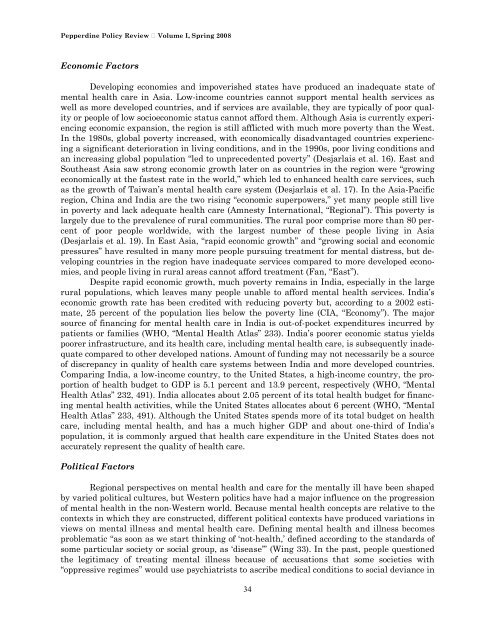Pepperdine University School of Public Policy
Pepperdine University School of Public Policy
Pepperdine University School of Public Policy
You also want an ePaper? Increase the reach of your titles
YUMPU automatically turns print PDFs into web optimized ePapers that Google loves.
<strong>Pepperdine</strong> <strong>Policy</strong> Review Volume I, Spring 2008<br />
Economic Factors<br />
Developing economies and impoverished states have produced an inadequate state <strong>of</strong><br />
mental health care in Asia. Low-income countries cannot support mental health services as<br />
well as more developed countries, and if services are available, they are typically <strong>of</strong> poor quality<br />
or people <strong>of</strong> low socioeconomic status cannot afford them. Although Asia is currently experiencing<br />
economic expansion, the region is still afflicted with much more poverty than the West.<br />
In the 1980s, global poverty increased, with economically disadvantaged countries experiencing<br />
a significant deterioration in living conditions, and in the 1990s, poor living conditions and<br />
an increasing global population “led to unprecedented poverty” (Desjarlais et al. 16). East and<br />
Southeast Asia saw strong economic growth later on as countries in the region were “growing<br />
economically at the fastest rate in the world,” which led to enhanced health care services, such<br />
as the growth <strong>of</strong> Taiwan’s mental health care system (Desjarlais et al. 17). In the Asia-Pacific<br />
region, China and India are the two rising “economic superpowers,” yet many people still live<br />
in poverty and lack adequate health care (Amnesty International, “Regional”). This poverty is<br />
largely due to the prevalence <strong>of</strong> rural communities. The rural poor comprise more than 80 percent<br />
<strong>of</strong> poor people worldwide, with the largest number <strong>of</strong> these people living in Asia<br />
(Desjarlais et al. 19). In East Asia, “rapid economic growth” and “growing social and economic<br />
pressures” have resulted in many more people pursuing treatment for mental distress, but developing<br />
countries in the region have inadequate services compared to more developed economies,<br />
and people living in rural areas cannot afford treatment (Fan, “East”).<br />
Despite rapid economic growth, much poverty remains in India, especially in the large<br />
rural populations, which leaves many people unable to afford mental health services. India’s<br />
economic growth rate has been credited with reducing poverty but, according to a 2002 estimate,<br />
25 percent <strong>of</strong> the population lies below the poverty line (CIA, “Economy”). The major<br />
source <strong>of</strong> financing for mental health care in India is out-<strong>of</strong>-pocket expenditures incurred by<br />
patients or families (WHO, “Mental Health Atlas” 233). India’s poorer economic status yields<br />
poorer infrastructure, and its health care, including mental health care, is subsequently inadequate<br />
compared to other developed nations. Amount <strong>of</strong> funding may not necessarily be a source<br />
<strong>of</strong> discrepancy in quality <strong>of</strong> health care systems between India and more developed countries.<br />
Comparing India, a low-income country, to the United States, a high-income country, the proportion<br />
<strong>of</strong> health budget to GDP is 5.1 percent and 13.9 percent, respectively (WHO, “Mental<br />
Health Atlas” 232, 491). India allocates about 2.05 percent <strong>of</strong> its total health budget for financing<br />
mental health activities, while the United States allocates about 6 percent (WHO, “Mental<br />
Health Atlas” 233, 491). Although the United States spends more <strong>of</strong> its total budget on health<br />
care, including mental health, and has a much higher GDP and about one-third <strong>of</strong> India’s<br />
population, it is commonly argued that health care expenditure in the United States does not<br />
accurately represent the quality <strong>of</strong> health care.<br />
Political Factors<br />
Regional perspectives on mental health and care for the mentally ill have been shaped<br />
by varied political cultures, but Western politics have had a major influence on the progression<br />
<strong>of</strong> mental health in the non-Western world. Because mental health concepts are relative to the<br />
contexts in which they are constructed, different political contexts have produced variations in<br />
views on mental illness and mental health care. Defining mental health and illness becomes<br />
problematic “as soon as we start thinking <strong>of</strong> ‘not-health,’ defined according to the standards <strong>of</strong><br />
some particular society or social group, as ‘disease’” (Wing 33). In the past, people questioned<br />
the legitimacy <strong>of</strong> treating mental illness because <strong>of</strong> accusations that some societies with<br />
“oppressive regimes” would use psychiatrists to ascribe medical conditions to social deviance in<br />
34












